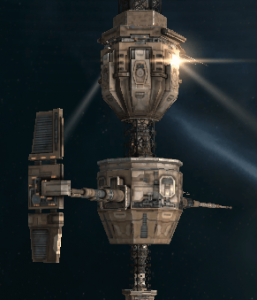Technetium is a valuable resource mined from a certain type of moon found in 0.0 space. Its value comes predominantly from the fact that it is used in every Tech 2 module and ship. Tech 2 modules are more advanced versions of normal modules which are fitted to ships. These can be anything from afterburners to warp disrupters. Anyone who can get their hands on it has a military advantage. Due to this fact, there was in 2012 – and remains, to a lesser extent – a large market for technetium.
Enterprising industrialists would buy technetium en masse from 0.0 empires. Then, they would use it to produce various modules which they could then sell for profit. This income was used by 0.0 empires to fund Ship Replacement Programs (SRPs).
This is important to the directorate of major organisations because SRPs gave players an incentive to go on operations, knowing that they had little to lose personally. Moreover, it is important to the health of the game itself. This is because it promotes aggressive game play which generates content and makes the overall game more exciting.

However, one major drawback of using technetium as an economic bedrock was that they could only be extracted by Moon Mining Arrays attached to player owned stations anchored above the requisite moons. The issue with these was that whilst they could not be easily destroyed, they could be put into reinforced mode easily. This stopped them from mining.
Therefore, in 2010 and 2011 it became a common practice for small fleets to attack player owned stations mining technetium. This would put them into reinforced mode, with the intention of disrupting the extraction of technetium.
These attacks were not fatal to alliance economy, as reinforced mode did not last particularly long. However, they were deeply problematic for the finance and logistics directors of various alliances. This was because they created a great deal more work, disrupting timetables. It also reduced the capacity of alliances to easily pay SRPs.
This problem reached a crisis point in early hours of the morning of the 11th of April 2012. Northern Coalition. . forces attempted to take over 2 technetium moons belonging to Clusterfuck Coalition (CFC) allies. Therefore, in late April 2012, CFC diplomats reached out to other major blocs across New Eden. Their objective was to find some sort of way to ensure the security of technetium. The product of these negotiations came to be known as the Organisation of Technetium Exporting Corporations (OTEC).

At its core, OTEC had two components. The first was a stipulation for all parties to engage in significant market manipulation to inflate the price of technetium. The second was a broad agreement for signatories not to attack each other’s technetium moons.
The first component, that of market manipulation, was relatively easy to achieve and was directly beneficial for all parties. This was because the only source of technetium was in nullsec. 90% of that was controlled by signatories to the agreement. Therefore, it was simple for the market teams of various coalitions to cooperate in decreasing the supply. This raised the cost significantly for the rest of the game.
This economic agenda was reinforced by terror against dwellers in high security space launched by nullsec alliances. They would destroy vulnerable ships, therefore artificially increasing the demand for new ones, many of which used technetium. One particular campaign which used this principle was Hulkageddon 2012.
Previously, Hulkageddon was organised by a noted pirate called Helicity Boson. It used his own funds assisted by donations from interested players. Its purpose was to incentivise players to destroy Hulks (a specific type of mining ship). It would do this by giving a reward to the player who destroyed the most Hulks within a week, along with various other cash rewards.
In previous years, this had achieved remarkable results, with over 1000 Hulks (and roughly £2000) destroyed in just one week.
However, this changed in 2012 when Goonswarm reached out to Helicity. They wanted to fund the effort on an industrial scale. Their intention, as announced by TheMittani, was to maintain Hulkageddon indefinitely. This would ensure that technetium was always in high demand, as a key component of Hulks is technetium.
This succeeded immensely, with approximately 2 trillion ISK (£24,000) destroyed over a period of two months. CCP did eventually act to stem this by boosting the protective capabilities of mining vessels. Despite this, Hulkageddon proved to be a highly effective market manipulation strategy.
This was aided by the Burn Jita event. Due to Jita’s status as the trade capital of New Eden, it sees high traffic. As it is in high-security space, any efforts to disrupt trade are difficult at best. However, Goonswarm was eager to attempt this, and on Friday April 27th they attacked into Jita.
Over the course of that weekend, 540 billion ISK (approximately £6,500) was destroyed. This ratcheted up prices even further and leading to general anxiety in the market. These two events served to seriously impact the high-sec market for technetium. Nullsec financial teams made a great deal of money. Goonswarm was very visible in these efforts, in part due to their typecasting as the villains of New Eden. Other nullsec alliances undertook similar measures as part of a coordinated campaign of economic terror.
The second element of the OTEC agreement was a diplomatic consensus for signatories not to attack each other’s technetium moons. It represented one of the first key multilateral diplomatic agreements in EVE history. But there was another element beyond this. And that was that the cartel members agreed to defend each other’s technetium moons to a certain extent.
A key incident when this occurred was on May 8th 2012, when Goonswarm, Northern Coalition. . and Pandemic Legion formed a combined fleet of over 700 people. This was to defend one of Pandemic Legion’s technetium moons against Against All Authorities. This show of force was intended to dissuade non-OTEC groups from attempting to deprive OTEC members of technetium resources.
Whilst the combined operation ended inconclusively, with Pandemic Legion able to repel the AAA forces on their own. However, the clear and decisive response showed that all partners held OTEC as highly important from a geopolitical standpoint. Unfortunately, this accord was to be seriously weakened by the growing dispute between NCdot and the CFC.